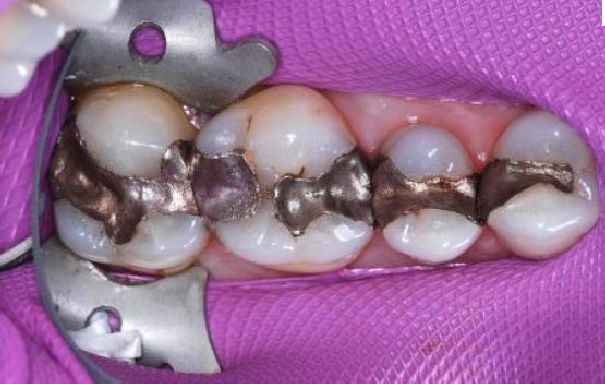Mercury Amalgam Filling Removal
Andrea writes - Many people have concerns and fears over the safety of mercury amalgam fillings. You may already know that amalgam fillings are made up of mercury, silver, tin, copper and zinc. Mercury comprises up to 50% of the amalgam filling. As such Milford Dentists stopped using mercury amalgam in 1999. It was around this time that a growing number of my patients asked me, for various reasons to have their mercury amalgam fillings removed & replaced with bonded, tooth coloured, non metallic restorations ie white composite resin fillings or porcelain crowns. The conversation would go something like this
Andrea - "Are you sure you want to replace all these old mercury amalgams…… they look OK on the x-rays & you're not getting any symptoms from them"
Patient - "I've thought about it & I have always hated them……. they look so ugly …….. & I don't like the thought of having mercury in my mouth" Decay is almost always present under old mercury dental amalgam. Milford Dentists, North Shore, Auckland

In 1999, the tooth coloured composite resin filling I started using & the techniques to actually strongly bond the tooth together had been improved to the point where, I believe, it was a better filling material than mercury amalgam. As a consequence of this I would remove the old mercury amalgams & replace with a tooth coloured filling or porcelain crown/overlay. Worryingly, I would find, in about 50% of these old amalgams either undiagnosed decay or an undiagnosed crack in the tooth or both.
Now, over a decade later all those old mercury amalgam fillings are even older & almost every one I remove that is a medium sized or bigger has decay & or structurally bad cracks/fracture lines in it. Often these mercury amalgam fillings were placed in childhood or early teens so some of them are 20 to 40 odd years old (or even older)
I now know a lot more about how teeth with mercury amalgam fillings behave together.
These old amalgams are not actually attached to the tooth – they just fill the hole
Read our blog about mercury amalgam versus white fillings for more info
When the amalgam filling heats up (eg when you have a hot drink) the metal, especially the mercury, expands (think mercury in a thermometer). This expansion puts stress on the enamel cusps over and over again. Eventually years later the cusps develop stress fractures & crack. Sometimes the cusps crack off above the gum line. Sometimes the tooth will crack below the gum & need to be extracted
When the amalgam filling heats up & expands (eg having a cup of tea) & then cools down contracting (eating ice cream) gaps open up around the filling.
There are now machines designed to mimic the forces exerted on teeth during ordinary chewing. When an extracted tooth, which has a medium sized mercury amalgam filling, is placed in this chewing machine, the tooth twists, bends & flexes. The cusps on either side of the amalgam filling move independently as the mercury amalgam filling does not bond, glue or hold the tooth together. The amalgam filling also moves. If the amalgam filling is now removed & a white composite resin filling is bonded in to the same cavity the amazing properties of composite resin fillings can be seen. When the tooth is put back in the chewing machine & the same forces are applied the tooth & white filling twist, bend & flex fully 26 times less than the the same tooth with the mercury amalgam filling. Essentially replacing mercury amalgam fillings with white composite resin makes the tooth stronger. Almost as strong as the tooth was before it decayed.
Learning about biomimetic dentistry was a real turning point for me. Biomimetics means life like. An American dentist called Dr Dave Allerman pioneered with his colleagues the chewing machine described above to illustrate the benefits of bonded composite resins. He then created a way of strongly bonding white composite resin to the tooth to recreate the join between enamel and dentine. Following this bonding process, I can now bond white composite resin into cavities that almost mimics how the original tooth was prior to it decaying, increasing the tooth strength a long the way. Dave was also instrumental in creating a protocol to bond a very strong fibrous mat into the composite resin filling. I use this mat (called Ribbond) to bond tooth fractures together. It is incredibly strong – it is similar to the Kevlar found in bullet proof vests.
If you have concerns over your health with regard to your amalgam fillings then we can discuss with you at a consultation how we can safely and easily remove these fillings. We can then reconstruct your teeth using metal free alternatives, such as -
• porcelain CAD/CAM E4D overlays, onlays or crowns
• tooth coloured composite resin
At Milford Dentists we can remove several amalgam fillings safely in one single visit. Some of the protocols we employ on request are -
• Using Rubber Dam - this is a rubber sheet that isolates the teeth to be operated on to prevent amalgam being swallowed or inhaled.Rubber dam is used here to isolate teeth from the rest of the mouth prior to mercury amalgam filling replacement.
• Oxygen – piped oxygen for you during the procedure.
• Vapour & amalgam slurry extraction – We use powerful high speed suction to evacuate the rubber dam area of the amalgam slurry & vapour.

We are happy to work in with complimentary and or mainstream practitioners who will often augment our dental treatment with IV or tablets of vitamin C, charcoal scavenger tablets etc.
Milford Dentists your local mercury amalgam removal dentists